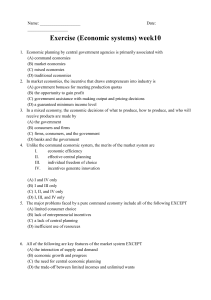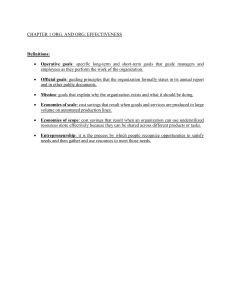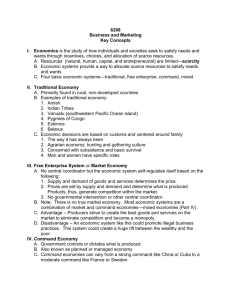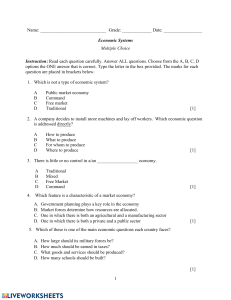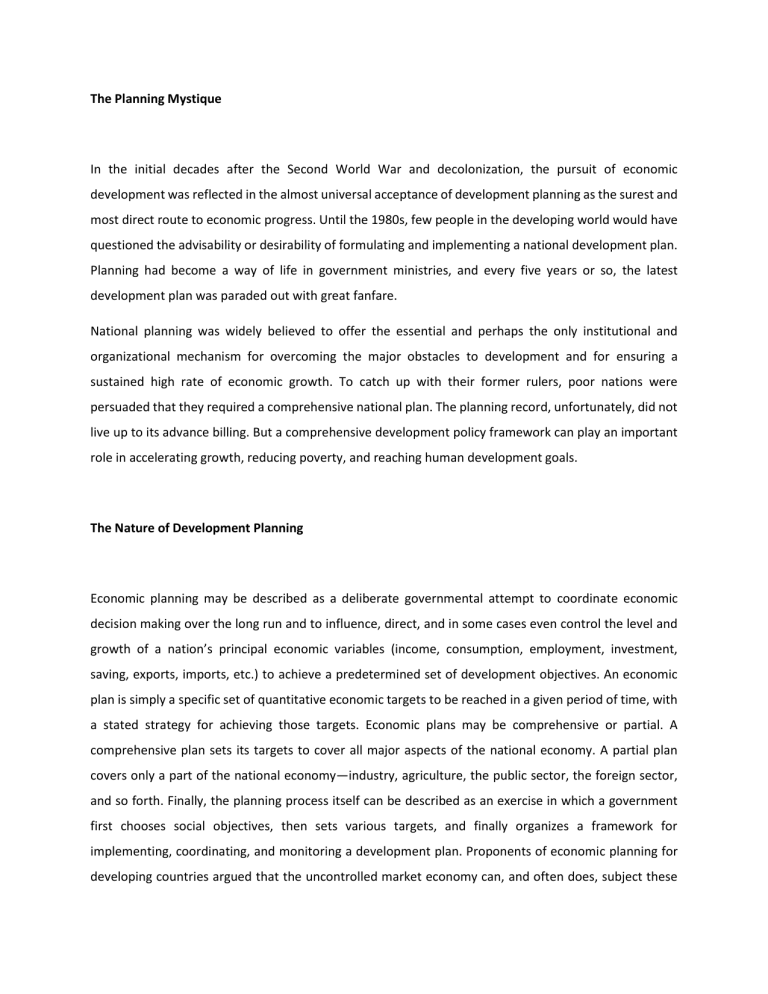
The Planning Mystique In the initial decades after the Second World War and decolonization, the pursuit of economic development was reflected in the almost universal acceptance of development planning as the surest and most direct route to economic progress. Until the 1980s, few people in the developing world would have questioned the advisability or desirability of formulating and implementing a national development plan. Planning had become a way of life in government ministries, and every five years or so, the latest development plan was paraded out with great fanfare. National planning was widely believed to offer the essential and perhaps the only institutional and organizational mechanism for overcoming the major obstacles to development and for ensuring a sustained high rate of economic growth. To catch up with their former rulers, poor nations were persuaded that they required a comprehensive national plan. The planning record, unfortunately, did not live up to its advance billing. But a comprehensive development policy framework can play an important role in accelerating growth, reducing poverty, and reaching human development goals. The Nature of Development Planning Economic planning may be described as a deliberate governmental attempt to coordinate economic decision making over the long run and to influence, direct, and in some cases even control the level and growth of a nation’s principal economic variables (income, consumption, employment, investment, saving, exports, imports, etc.) to achieve a predetermined set of development objectives. An economic plan is simply a specific set of quantitative economic targets to be reached in a given period of time, with a stated strategy for achieving those targets. Economic plans may be comprehensive or partial. A comprehensive plan sets its targets to cover all major aspects of the national economy. A partial plan covers only a part of the national economy—industry, agriculture, the public sector, the foreign sector, and so forth. Finally, the planning process itself can be described as an exercise in which a government first chooses social objectives, then sets various targets, and finally organizes a framework for implementing, coordinating, and monitoring a development plan. Proponents of economic planning for developing countries argued that the uncontrolled market economy can, and often does, subject these nations to economic dualism, unstable markets, low investment in key sectors, and low levels of employment. In particular, they claimed that the market economy is not geared to the principal operational task of poor countries: mobilizing limited resources in a way that will bring about the structural change necessary to stimulate a sustained and balanced growth of the entire economy. Planning came to be accepted, therefore, as an essential and pivotal means of guiding and accelerating economic growth in almost all developing countries. Planning in Mixed Developing Economies Most development plans have been formulated and carried out within the framework of the mixed economies of the developing world. These economies are characterized by the existence of an institutional setting in which some of the productive resources are privately owned and operated and some are controlled by the public sector. The actual proportionate division of public and private ownership and control varies from country to country, and neither the private nor the public sector can really be considered in isolation from the other. However, mixed economies are often distinguished by a substantial amount of government ownership and control. The private sector in developing countries typically comprises four traditional forms of private ownership and a more recent emerging one : 1. The subsistence sector, consisting of small-scale private farms and handicraft shops selling a part of their production to local markets 2. Small-scale individual or family-owned commercial business and service activities in the formal and informal urban sectors 3. Medium-size commercial enterprises in agriculture, industry, trade, and transport owned and operated by local entrepreneurs 4. Large jointly owned or completely foreign-owned manufacturing enterprises, mining companies, and plantations, catering primarily to foreign markets but sometimes with substantial local sales (the capital for such enterprises usually comes from abroad, and a good proportion of the profits tends to be transferred overseas) 5. A growing number of relatively large, domestic-based firms, primarily locally managed and largely locally owned, often listed on national stock markets in countries such as Brazil, Russia, India, and China but much more common in middle-income than low-income countries and rare in the least developed countries In the context of such an institutional setting, we can identify two principal components of development planning in mixed economies: 1. The government’s deliberate use of domestic saving and foreign finance to carry out public investment projects and to mobilize and channel scarce resources into areas that can be expected to make the greatest contribution toward the realization of long-term economic objectives (e.g., the construction of railways, schools, hydroelectric projects, and other components of economic infrastructure, as well as the creation of import-substituting industries or projected future export sectors) 2. Governmental economic policy (e.g., taxation, industrial licensing, the setting of tariffs, and the manipulation of quotas, wages, interest rates, and prices) to stimulate, direct, and in some cases even control private economic activity so as to ensure a harmonious relationship between the desires of private business operators and the social objectives of the central government Thus even when development planning is quite active, there is almost always a balance between the extremes of market inducement and central control, as is readily evident from our simplified characterization of planning in mixed market economies. The Rationale for Development Planning The early widespread acceptance of planning as a development tool rested on a number of fundamental economic and institutional arguments. Of these we can single out four as the most often put forward. Market Failure Markets in developing economies are permeated by imperfections of structure and operation. Commodity and factor markets are often badly organized, and the existence of distorted prices often means that producers and consumers are responding to economic signals and incentives that are a poor reflection of the real cost to society of these goods, services, and resources. It is therefore argued that governments have an important role to play in integrating markets and modifying prices. Moreover, the failure of the market to price factors of production correctly is further assumed to lead to gross disparities between social and private valuations of alternative investment projects. In the absence of governmental interference, therefore, the market is said to lead to a misallocation of present and future resources or, at least, to an allocation that may not be in the best long-run social interests. This market failure argument is perhaps the most often quoted reason for the expanded role of government in less developed countries. Various kinds of market and government failures are examined in several of the earlier chapters, but a brief review is in order here. There are three general forms in which market failure can be observed: The market cannot function properly or no market exists; the market exists but implies an inefficient allocation of resources; the market produces undesirable results as measured by social objectives other than the allocation of resources. Market failures can occur in situations in which social costs or benefits differ from the private costs or benefits of firms or consumers; public goods, externalities, and market power are the best-known examples. With public goods, “free riders” who do not pay for the goods cannot be excluded except at high cost; it is economically inefficient to exclude nonpaying individuals from consuming these goods. With externalities, consumers or firms do not have to pay all the costs of their activities or are unable to receive all the benefits. Coordination failures occur when several agents would be better off if they could cooperate on actions if all or most agents participate but worse off taking the action if too few participate. Moreover, economic development is a process of structural change. The market may be efficient in allocating resources at the margin, allowing certain industries to emerge and others to fail, but may be ineffective in producing large discontinuous changes in the economic structure that may be crucial to the country’s long-term development (see Chapter 4).5 Market power occurs when firms can influence price by restricting quantity, a power most common under increasing returns to scale. Capital markets are particularly prone to failure due to their intrinsic connection to information generation and transmittal; information has public-good properties (see Chapter 15). A more equal distribution of income itself can be considered a public good when it is an agreed social objective. There may be concern for the well-being of future generations, who cannot participate in today’s economic or political markets. Merit goods, such as health, education, and basic welfare, can also be considered public goods or social entitlements guaranteed by government. But concerns about distribution and merit goods are often treated as separate rationales for policy because their levels are generally viewed as outside the realm of economic efficiency. Unfortunately, we cannot jump to the conclusion that if economic theory says policy can fix market failures, it will do so in practice. Government failure may also occur in the many cases in which politicians, bureaucrats, and the individuals or groups who influence them give priority to their own private interests rather than the public interest. Analysis of incentives for government failure helps guide reforms such as constitution design and civil service rules. Developing countries tend to have both high market failure and government failure. (As noted later in the chapter, the NGO sector can also be subject to what is termed voluntary failure, for several reasons). Resource Mobilization and Allocation This argument stresses that developing economies cannot afford to waste their very limited financial and skilled human resources on unproductive ventures. Investment projects must be chosen not solely on the basis of partial productivity analysis dictated by individual industrial capital-output ratios but also in the context of an overall development program that takes account of external economies, indirect repercussions, and long-term objectives. Skilled workers must be employed where their contribution will be most widely felt. Economic planning is assumed to help by recognizing the existence of particular constraints and by choosing and coordinating investment projects so as to channel these scarce factors into their most productive outlets. In contrast, it is argued, competitive markets will tend to generate less investment and to direct that investment into areas of low social priority (e.g., consumption goods for the rich). Attitudinal or Psychological Impact It is often assumed that a detailed statement of national economic and social objectives in the form of a specific development plan can have an important attitudinal or psychological impact on a diverse and often fragmented population. It may succeed in rallying the people behind the government in a national campaign to eliminate poverty, ignorance, and disease or to boost national prowess. By mobilizing popular support and cutting across class, caste, racial, religious, or tribal factions with the plea to all citizens to work together toward building the nation, it is ar- gued that an enlightened central government, through its economic plan, can best provide the needed incentives to overcome the inhibiting and often divisive forces of sectionalism and traditionalism in a common quest for widespread material and social progress. Foreign Aid The formulation of detailed development plans has often been a necessary condition for the receipt of bilateral and multilateral foreign aid. With a shopping list of projects, governments are better equipped to solicit foreign assistance and persuade donors that their money will be used as an essential ingredient in a well-conceived and internally consistent plan of action.

